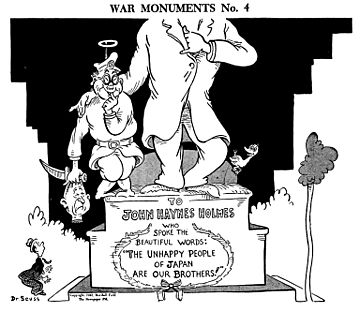John Haynes Holmes facts for kids
Quick facts for kids
John Haynes Holmes
|
|
|---|---|
 |
|
| President of the American Civil Liberties Union | |
| In office 1940–1950 |
|
| Preceded by | Harry F. Ward |
| Succeeded by | Ernest Angell |
| Personal details | |
| Born | November 29, 1879 Philadelphia, Pennsylvania, U.S. |
| Died | April 3, 1964 (aged 84) Manhattan, New York, U.S. |
| Spouses |
Madeleine Baker
(after 1904) |
| Relations | Newland H. Holmes (cousin) |
| Children | 2 |
| Alma mater | Harvard University Harvard Divinity School |
John Haynes Holmes (born November 29, 1879 – died April 3, 1964) was an American minister. He was a strong believer in peace and worked hard to stop wars. He also helped start two very important groups: the NAACP and the ACLU. These groups work to protect people's rights.
Contents
Early Life and Education
John Haynes Holmes was born in Philadelphia, Pennsylvania, on November 29, 1879. He grew up in Malden, a town near Boston.
He went to Harvard University and graduated in 1902. After that, he studied at Harvard Divinity School to become a minister. He finished his studies in 1904 and started his first job as a minister in Dorchester, Massachusetts.
Career as a Minister and Activist
In 1907, Holmes moved to New York City to lead a church called the Church of the Messiah. He was the Senior Minister there until 1918. During World War I, he strongly believed that the United States should not join the war. This was a very unpopular idea at the time.
Because of his strong views on peace, he left the American Unitarian Association. His church supported him and changed its name to the "Community Church of New York." He continued to lead this church until he retired in 1949.
Holmes worked with leaders from different religions. He was good friends with Rabbi Stephen Samuel Wise and they worked together on many social and religious issues. Holmes also supported Zionism, which was a movement to create a safe home for Jewish people. He also admired Mahatma Gandhi and his peaceful ways. Holmes even wrote a book about Gandhi called My Gandhi.
Besides his work as a minister, Holmes was a key figure in starting important organizations. In 1909, he helped create the NAACP. This group fights for the rights of African Americans. In 1920, he also helped start the ACLU. The ACLU works to protect the civil rights and freedoms of all Americans. He was the chairman of the ACLU from 1940 to 1950.
Holmes also wrote many books and even a play. His play, If This Be Treason, showed his strong feelings against war. He was also a popular speaker and enjoyed debating important topics.
Facing Criticism for His Views
John Haynes Holmes's strong belief in peace, especially during wartime, was not always popular. During World War II, a famous cartoonist named Theodor Geisel, better known as Dr. Seuss, drew a cartoon that made fun of Holmes. The cartoon suggested that Holmes's peaceful ideas were not helpful when the country was at war.
Dr. Seuss wrote that while he believed in peace, he felt it was not the time for it when the country was fighting. He said that winning the war was most important.
Holmes faced a lot of criticism and even ridicule for his views. He had to leave his church's main group during World War I because he refused to stop speaking out against the war. Despite this, he continued to defend his beliefs strongly. He famously said in 1917 that his church would always be dedicated to human brotherhood and peace.
Personal Life
In 1904, John Haynes Holmes married Madeleine Hosmer Baker. They had two children, a son named Roger and a daughter named Frances.
His wife passed away in 1961. John Haynes Holmes died on April 3, 1964, at the age of 84, in his home in New York City. His funeral was attended by many friends and admirers.
Works
- New Wars for Old (1916)
- Palestine To-Day and To-Morrow: A Gentile's Survey of Zionism (1929)
- My Gandhi (1953)
- I Speak for Myself (1959)


